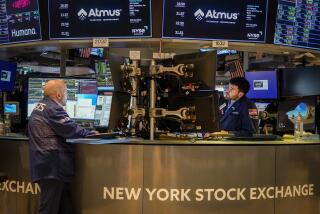As Mid-Caps Rally, Investors Fear a Rate Hike
- Share via
Will the Federal Reserve put an end to the mid-cap party?
Mid-cap stocks--those with market capitalizations generally between $1 billion and $5 billion--have been solid performers as the market has broadened recently.
The Standard & Poor’s mid-cap 400 index has climbed 12.6% in the last three months, bettering the gains of 10.5% in the S&P; small-cap 600 and 8.5% in the S&P; 500. On Wednesday, the mid-caps rose 1.4%, versus 0.8% for the big-caps and 0.4% for the small-caps.
For the year to date, however, large caps maintain a wide lead over the competing sectors.
Strong earnings, improved mutual fund inflows and investors’ willingness to venture beyond big-name growth stocks have carried the sector, said L. Keith Mullins, strategist at Salomon Smith Barney.
“It has all the hallmarks of a real advance,” Mullins said. Among the stocks he likes: Dollar Tree Stores (ticker symbol: DLTR), Nova Corp. (NIS) and Paychex (PAYX).
The big question, though, is whether a Federal Reserve rate hike would halt the mid-cap advance.
The central bank said Tuesday that it is leaning toward raising rates in the future, and some Wall Streeters believe that a rate hike will come by the fall. Rising rates increase corporate borrowing costs and make bond yields more attractive relative to stocks.
Investors might be particularly wary of all but the largest and most liquid stocks if higher rates make the investment outlook more uncertain.
“The Fed could put an end to this rally very quickly,” Mullins said, echoing the views of most on Wall Street.
Some optimists, however, say a rate hike wouldn’t devastate mid-caps. It would demonstrate that the economy is strong and stir enthusiasm about near-term corporate profits, the very reasons, after all, that investors are drawn to mid-caps.
“I think it could actually be positive for the small- to mid-cap stocks,” said Scott Billeadeau, a money manager at TradeStreet Investment Associates in Charlotte, N.C.
Mid-caps also could benefit if investors seek refuge from big-name stocks with rich valuations, they say.
Small-caps have been helped by the same forces driving mid-caps, but mid-caps have something else going their way. They boast greater liquidity--meaning institutional investors can more easily sell shares in a hurry if they need to--than small-caps. That’s made skittish professionals more willing to stick cash into mid-caps.
“It’s almost a chicken-hearted way of playing the small-caps,” said Ken Zschappel, co-manager of the mid-cap AIM Constellation fund. He likes Analog Devices (ADI), Adelphia Communications (ADLAC) and Abercrombie & Fitch (ANF).
On top of valuation worries over large stocks, mid-caps have been boosted by a recent drop in volatility that has reduced fears about the sector, said Satya Pradhuman, small-cap research director at Merrill Lynch & Co.
And “as the market broadens out, it doesn’t take much [cash] to move these small and mid-cap stocks,” Billeadeau said. He’s high on telecom stocks Uniphase (UNPH), ADC Telecommunications (ADCT) and ECI Telecom (ECILF).
Times staff writer Walter Hamilton will be moderating several stock-picking panels at The Times’ 1999 Investment Strategies Conference, to be held this weekend at the Los Angeles Convention Center. For registration information, call (800) 350-3211. Hamilton can be reached at walter.hamilton@latimes.com.
(BEGIN TEXT OF INFOBOX / INFOGRAPHIC)
Not Stuck in the Middle
Though it hasn’t been the biggest gainer in the last three months, the Standard & Poor’s 400-stock mid-cap index has outperformed several other leading U.S. indexes. Three-month percentage gains through Wednesday:
Dow Jones industrials: 16.6%
Nasdaq composite: 12.9
S&P; 400 mid-cap: 12.6
S&P; 600 small-cap: 10.5
NYSE composite: 9.0
S&P; 500: 8.5
Source: Bloomberg News
More to Read
Inside the business of entertainment
The Wide Shot brings you news, analysis and insights on everything from streaming wars to production — and what it all means for the future.
You may occasionally receive promotional content from the Los Angeles Times.










